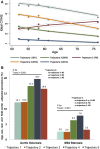Ideal Cardiovascular Health and the Prevalence and Severity of Aortic Stenosis in Elderly Patients
- PMID: 29431107
- PMCID: PMC5850241
- DOI: 10.1161/JAHA.117.007234
Ideal Cardiovascular Health and the Prevalence and Severity of Aortic Stenosis in Elderly Patients
Abstract
Background: The relationship between ideal cardiovascular health reflected in the cardiovascular health score (CVHS) and valvular heart disease is not known. The purpose of this study was to determine the association of CVHS attainment through midlife to late life with aortic stenosis prevalence and severity in late life.
Methods and results: The following 6 ideal cardiovascular health metrics were assessed in ARIC (Atherosclerosis Risk in Communities) Study participants at 5 examination visits between 1987 and 2013 (visits 1-4 in 1987-1998 and visit 5 in 2011-2013): smoking, body mass index, total cholesterol, blood pressure, physical activity, and blood glucose. Percentage attained CVHS was calculated in 6034 participants as the sum of CVHS at each visit/the maximum possible score. Aortic stenosis was assessed by echocardiography at visit 5 on the basis of the peak aortic valve velocity. Aortic stenosis was categorized sclerosis, mild stenosis, and moderate-to-severe stenosis. Mean age was 76±5 years, 42% were men, and 22% were black. Mean percentage attained CVHS was 63±14%, and the prevalence of aortic stenosis stages were 15.9% for sclerosis, 4.3% for mild stenosis, and 0.7% for moderate-to-severe stenosis. Worse percentage attained CVHS was associated with higher prevalence of aortic sclerosis (P<0.001 for trend), mild stenosis (P<0.001), and moderate-to-severe stenosis (P=0.002), adjusting for age, sex, and race.
Conclusions: Greater attainment of ideal cardiovascular health in midlife to late life is associated with a lower prevalence of aortic sclerosis and stenosis in late life in a large cohort of older adults.
Keywords: aortic stenosis; echocardiography; epidemiology; primary prevention; risk factor.
© 2018 The Authors. Published on behalf of the American Heart Association, Inc., by Wiley.
Figures





Comment in
-
Health Behaviors and Calcific Aortic Valve Disease.J Am Heart Assoc. 2018 Feb 3;7(3):e008385. doi: 10.1161/JAHA.117.008385. J Am Heart Assoc. 2018. PMID: 29431108 Free PMC article. No abstract available.
References
-
- Stewart BF, Siscovick D, Lind BK, Gardin JM, Gottdiener JS, Smith VE, Kitzman DW, Otto CM. Clinical factors associated with calcific aortic valve disease: Cardiovascular Health Study. J Am Coll Cardiol. 1997;29:630–634. - PubMed
-
- Varadarajan P, Kapoor N, Bansal R, Pai R. Survival in elderly patients with severe aortic stenosis is dramatically improved by aortic valve replacement: results from a cohort of 277 patients aged ≥80 years. Eur J Cardiothorac Surg. 2006;30:722–727. - PubMed
-
- Kojodjojo P, Gohil N, Barker D, Youssefi P, Salukhe TV, Choong A, Koa‐Wing M, Bayliss J, Hackett DR, Khan MA. Outcomes of elderly patients aged 80 and over with symptomatic, severe aortic stenosis: impact of patient's choice of refusing aortic valve replacement on survival. QJM. 2008;101:567–573. - PubMed
-
- Otto CM, Lind BK, Kitzman DW, Gersh BJ, Siscovick DS. Association of aortic‐valve sclerosis with cardiovascular mortality and morbidity in the elderly. N Engl J Med. 1999;341:142–147. - PubMed
-
- Cosmi JE, Kort S, Tunick PA, Rosenzweig BP, Freedberg RS, Katz ES, Applebaum RM, Kronzon I. The risk of the development of aortic stenosis in patients with “benign” aortic valve thickening. Arch Intern Med. 2002;162:2345–2347. - PubMed
Publication types
MeSH terms
Substances
Supplementary concepts
Grants and funding
- R01 HL134168/HL/NHLBI NIH HHS/United States
- HHSN268201100005C/HL/NHLBI NIH HHS/United States
- HHSN268201100006C/HL/NHLBI NIH HHS/United States
- HHSN268201100007C/HL/NHLBI NIH HHS/United States
- HHSN268201100008C/HL/NHLBI NIH HHS/United States
- HHSN268201100009C/HL/NHLBI NIH HHS/United States
- HHSN268201100010C/HL/NHLBI NIH HHS/United States
- HHSN268201100011C/HL/NHLBI NIH HHS/United States
- HHSN268201100012C/HL/NHLBI NIH HHS/United States
- K08 HL116792/HL/NHLBI NIH HHS/United States
- R01 HL135008/HL/NHLBI NIH HHS/United States
- R01 HL131532/HL/NHLBI NIH HHS/United States
LinkOut - more resources
Full Text Sources
Other Literature Sources

